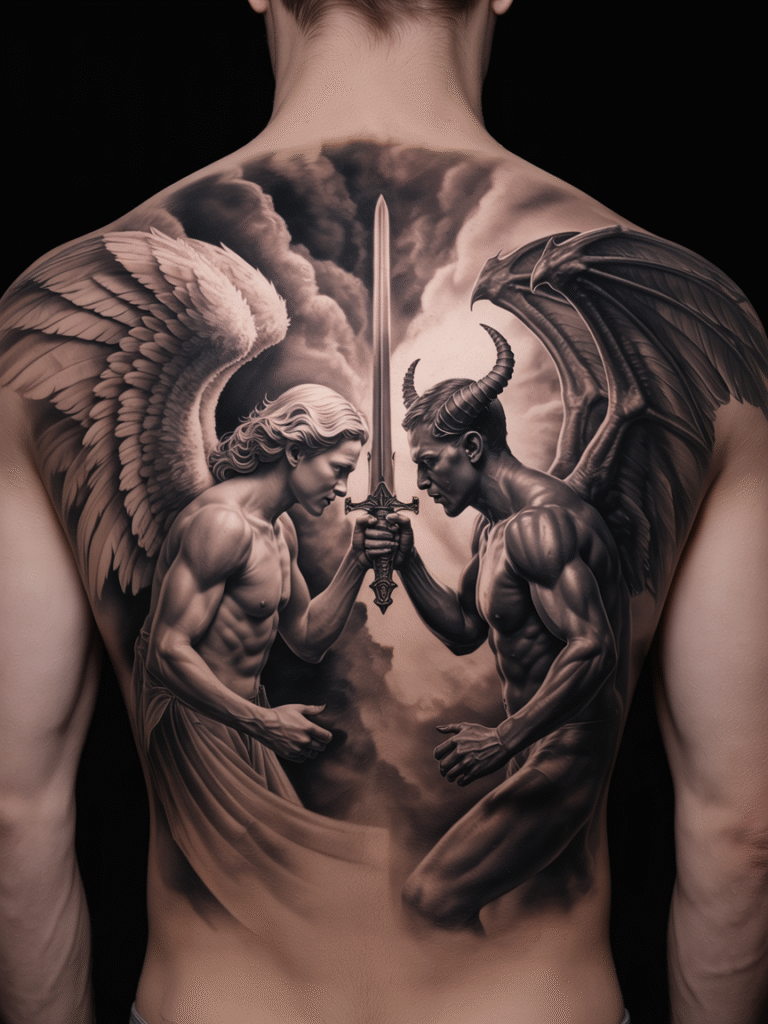Angel vs Devil tattoos represent one of the most powerful and symbolically rich designs in tattoo culture. These striking pieces capture the eternal struggle between light and darkness, good and evil, virtue and temptation that exists within every human soul. The dramatic contrast between angelic purity and demonic rebellion creates some of the most visually stunning and emotionally resonant tattoo art available today.
1. The Symbolic Foundation of Angel vs Devil Tattoos
The concept of angels and devils locked in eternal conflict spans across cultures and religions, making these tattoos universally understood symbols of internal struggle. Angels represent divine guidance, protection, morality, and spiritual ascension, while devils embody temptation, rebellion, earthly desires, and the darker aspects of human nature. Together, they symbolize the duality that exists within every person – the constant battle between doing what’s right and giving in to base impulses.
This symbolism resonates deeply with people who have experienced significant life struggles, overcome addiction, or faced moral crossroads. The tattoo serves as a permanent reminder of the ongoing choice between light and darkness, making it a powerful personal statement about one’s journey toward redemption or acceptance of their complex nature.
2. Historical and Cultural Origins of Good vs Evil Imagery
The imagery of angels battling demons has roots in ancient religious texts, medieval art, and classical literature. Christian traditions depict the war in heaven between Michael the Archangel and Lucifer, while similar themes appear in Islamic, Jewish, and other religious traditions. Renaissance artists like Michelangelo and Caravaggio created masterful depictions of this cosmic battle, influencing how we visualize these supernatural beings today.
In tattoo culture, angel vs devil designs gained popularity in the mid-20th century, particularly among those seeking to express their spiritual struggles or reformed lifestyle. The imagery became especially significant in prison culture and among those who had overcome difficult pasts, serving as both confession and commitment to change.
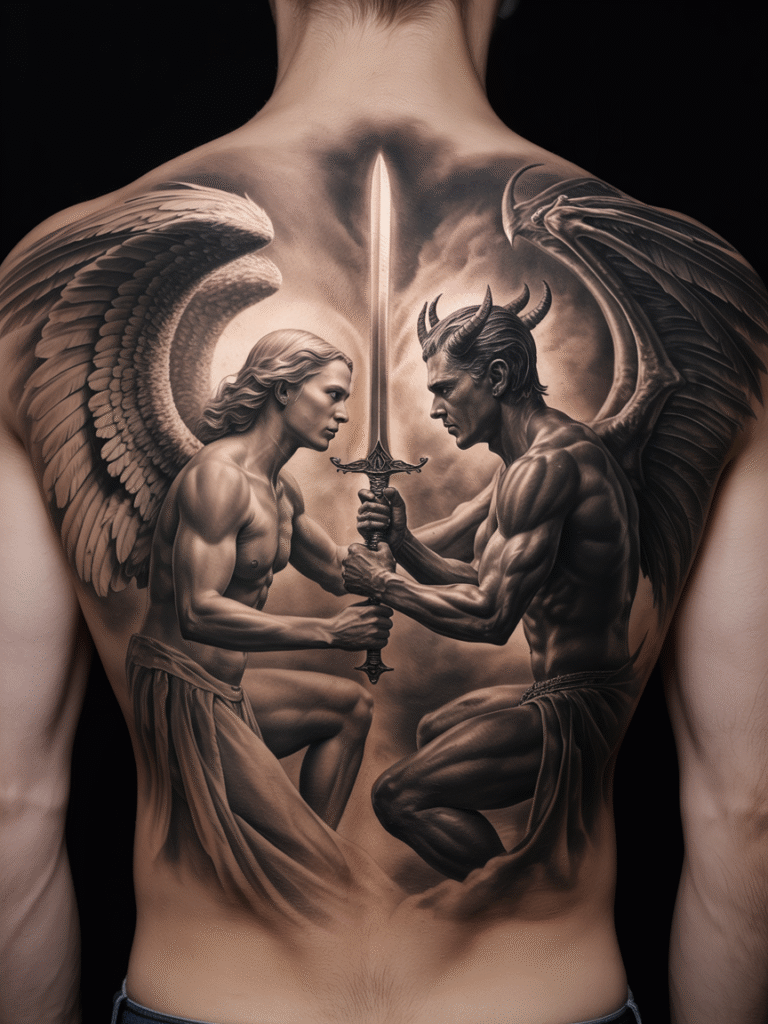
3. Design Variations and Artistic Interpretations
Angel vs devil tattoos offer endless creative possibilities, from realistic portraits to abstract interpretations. Traditional designs often feature a classic angel with white wings facing off against a horned devil with bat-like wings, typically positioned on opposite sides of the body or composition. The central element might be a sword, cross, or other symbolic object representing the battleground between these forces.
Modern interpretations have evolved to include more nuanced representations. Some designs show the same figure with both angelic and demonic features, representing internal conflict. Others depict the transformation from devil to angel or vice versa, symbolizing personal change or fall from grace. The artistic style can range from photorealistic portraits to traditional American tattoo styles, gothic imagery, or contemporary abstract designs.
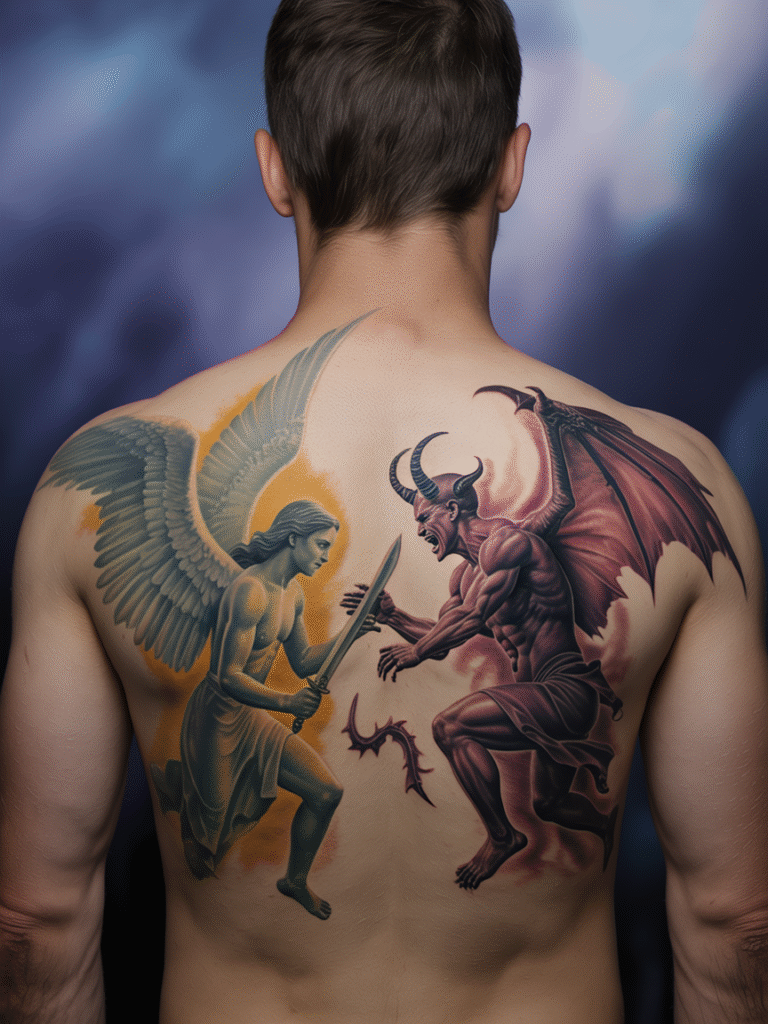
4. Placement Strategies for Maximum Impact
The placement of angel vs devil tattoos significantly affects their visual impact and symbolic meaning. Full back pieces, like those shown in professional portfolios, offer the largest canvas for detailed, dramatic compositions. This placement allows for intricate storytelling and impressive scale that commands attention and respect.
Chest pieces provide another powerful option, with the heart serving as the symbolic battleground between good and evil. Sleeve tattoos can tell the story progressively, with the transformation or battle unfolding as the eye travels along the arm. Shoulder blade placements work well for smaller interpretations, while some choose to split the design across both arms or shoulders, with the angel on one side and devil on the other.
5. Color Schemes and Their Psychological Impact
Color choices in angel vs devil tattoos carry deep psychological and symbolic weight. Traditional color schemes often contrast bright, pure whites and golds for angelic elements against deep reds, blacks, and dark purples for demonic features. This stark contrast enhances the visual drama and reinforces the fundamental opposition between the two forces.
Black and grey realism has become increasingly popular for these designs, creating sophisticated, fine-art quality pieces that emphasize form, shadow, and emotional expression over symbolic color coding. This approach often results in more psychologically complex and personally meaningful tattoos. Some artists incorporate selective color highlights – perhaps golden halos or red flames – against an otherwise monochromatic background for stunning visual impact.
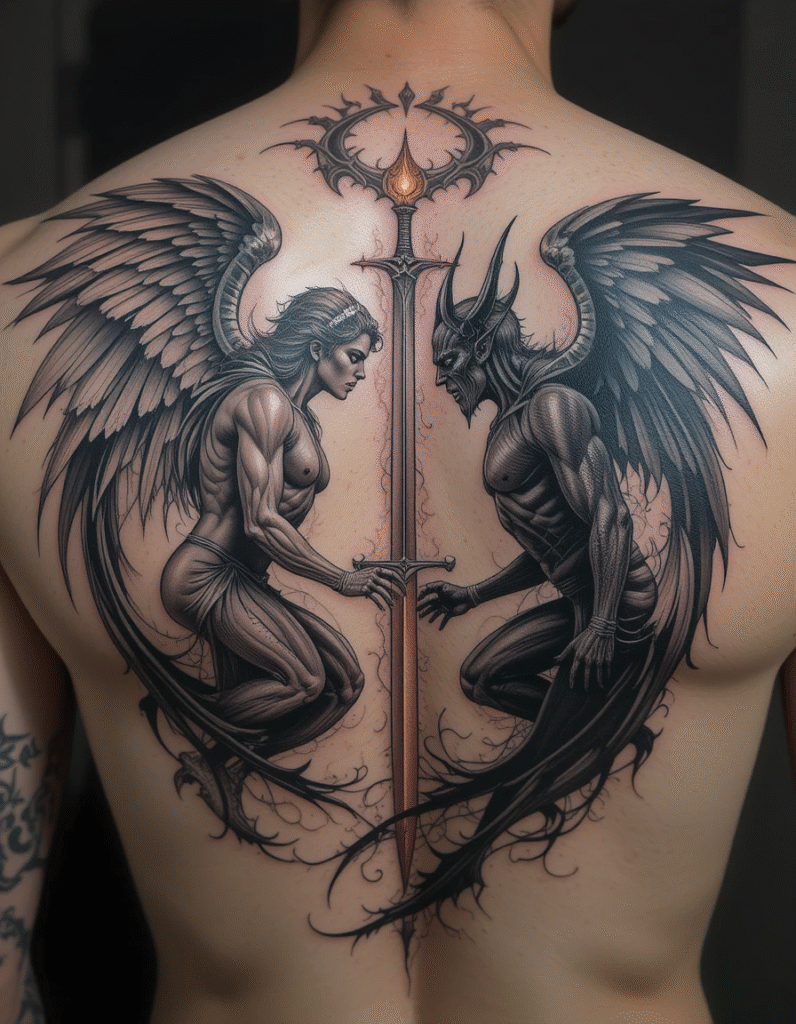
6. Incorporating Religious and Spiritual Elements
Many angel vs devil tattoos incorporate specific religious or spiritual symbols to deepen their meaning. Christian imagery might include crosses, biblical quotes, or specific archangels like Michael or Gabriel. Rosary beads, church architecture, or scenes from religious texts can provide additional context and personal significance.
Non-Christian spiritual elements can also enhance these designs. Celtic crosses, Norse mythology, Eastern spiritual symbols, or indigenous spiritual imagery can be woven into the composition to reflect the wearer’s specific beliefs or cultural background. The key is ensuring that all elements work harmoniously to support the overall theme while respecting the cultural significance of incorporated symbols.
7. The Role of Facial Expressions and Body Language
The emotional impact of angel vs devil tattoos often comes from the facial expressions and body language of the figures. Angels might be depicted with serene, compassionate expressions or fierce determination in battle. Their posture often conveys protection, blessing, or divine authority. Wings spread wide can suggest sheltering protection or readiness for battle.
Demonic figures, in contrast, might show cunning temptation, rage, or seductive appeal. Their body language often suggests aggression, manipulation, or predatory intent. The interaction between these opposing forces – whether they’re locked in combat, engaged in dialogue, or reaching for the same object – tells the story of the wearer’s personal struggle or worldview.
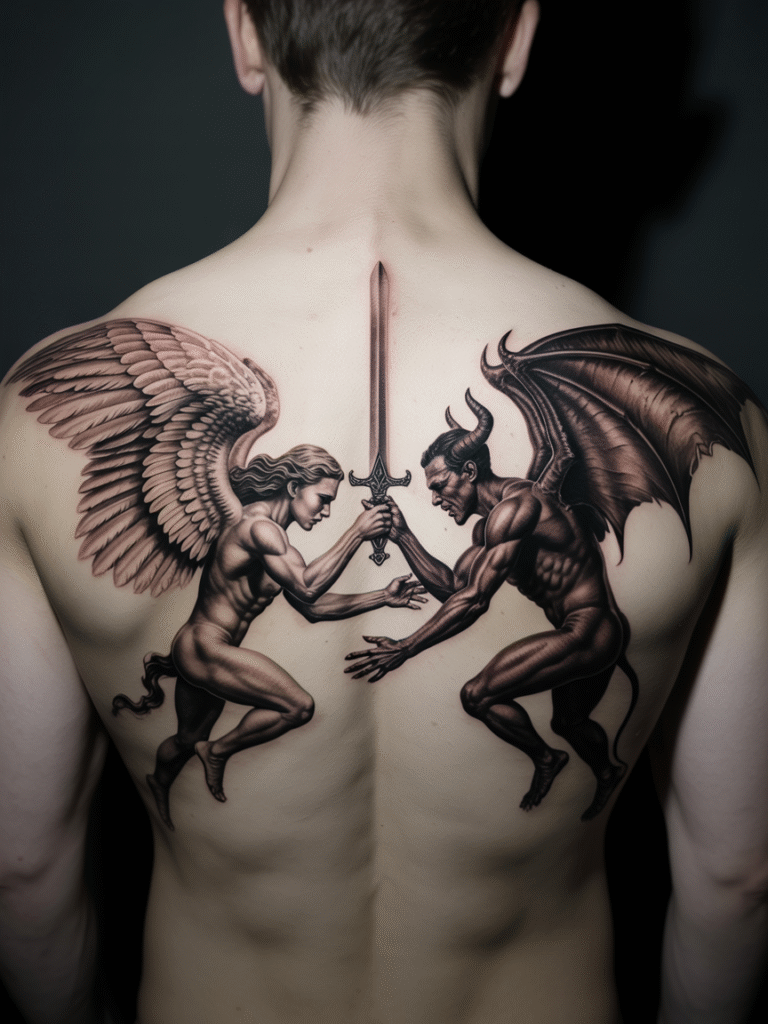
8. Technical Challenges and Artistic Mastery
Creating exceptional angel vs devil tattoos requires advanced technical skills and artistic mastery. The realistic portrayal of human figures, detailed wing feathers, and complex drapery demands expertise in proportion, anatomy, and shading techniques. The contrast between light and dark elements requires careful planning to ensure both sides remain visually balanced and impactful.
Artists must excel at creating depth, movement, and emotional expression while managing the technical challenges of large-scale compositions. The integration of background elements like clouds, flames, or architectural details adds another layer of complexity. Master tattoo artists often spend years developing the skills necessary to create these ambitious pieces successfully.
9. Size Considerations and Session Planning
Angel vs devil tattoos, particularly full back pieces or large chest compositions, represent significant undertakings that require careful planning and commitment. These designs typically require multiple sessions spanning several months or even years to complete. Each session might focus on specific elements – outlining, shading particular figures, or adding background details.
The size and complexity directly impact both the time investment and financial commitment required. Smaller interpretations can be completed in fewer sessions but may sacrifice some of the dramatic impact that makes these designs so compelling. Clients should discuss timeline expectations, session scheduling, and the overall completion strategy with their chosen artist before beginning the process.
10. Pain Management and Physical Considerations
Large angel vs devil tattoos often cover areas of the body with varying pain sensitivity levels. Back pieces, while offering excellent canvas space, involve extended work over the spine and shoulder blade areas, which can be particularly challenging. Proper pain management strategies, including adequate rest between sessions, proper nutrition, and mental preparation, become crucial for completing these ambitious projects.
The physical healing process for large tattoos also requires special attention. Multiple healing areas, careful clothing choices, and modified sleeping positions may be necessary during the completion process. Clients should prepare for the physical demands of large-scale tattooing and plan their schedules accordingly.
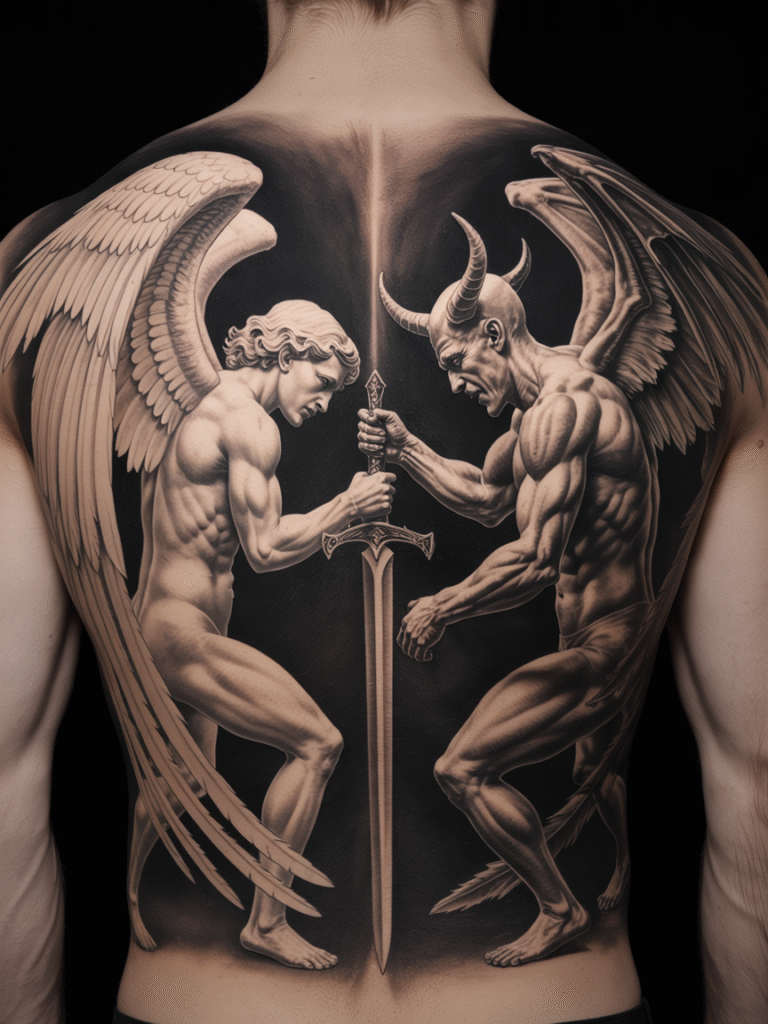
11. Personal Meaning and Emotional Significance
The decision to get an angel vs devil tattoo often stems from deeply personal experiences and spiritual journeys. These designs frequently commemorate overcoming addiction, surviving trauma, religious conversion, or other life-changing experiences. The tattoo becomes a permanent reminder of personal growth, internal struggles overcome, or ongoing commitment to positive change.
Some choose these designs to represent acceptance of their complex nature – acknowledging both their capacity for good and their human flaws. Others use the imagery to honor lost loved ones, with angels representing those who have passed and devils representing the grief or anger they’ve overcome. The personal significance makes each piece unique, even when following traditional design elements.
12. Choosing the Right Artist for Your Vision
Selecting an artist for angel vs devil tattoos requires careful consideration of their portfolio, experience with large-scale religious imagery, and understanding of the symbolic significance. Look for artists who demonstrate mastery in realistic figure work, complex compositions, and the ability to convey emotion through their art. Their portfolio should show experience with similar themes and the technical skills necessary for ambitious projects.
Schedule extensive consultations to discuss your vision, personal meaning, and artistic preferences. The right artist will help refine your concept while ensuring the final design maintains both visual impact and personal significance. They should be comfortable working with religious or spiritual imagery and respectful of the personal meaning behind your chosen design.
13. Maintenance and Long-term Care
Angel vs devil tattoos, especially large detailed pieces, require ongoing care to maintain their dramatic impact and fine details. Protect the tattoo from sun exposure with high-SPF sunscreen to prevent fading of both light and dark elements. Regular moisturizing helps maintain skin health and tattoo vibrancy, particularly important for pieces with extensive shading and detail work.
Schedule periodic touch-ups to address any fading or settling that occurs over time. Quality angel vs devil tattoos, when properly maintained, can retain their emotional impact and visual drama for decades. Consider your tattoo an investment in meaningful body art that will serve as a powerful personal statement throughout your life, connecting you to the eternal themes of human struggle and spiritual growth that these designs represent.

